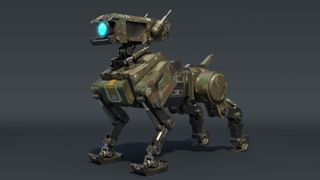MOV.AI’s robotics engine platform aids AMR production
New platform automates autonomous mobile robot development with visual IDE, open API framework, 3D physics simulator, and more

MOV.AI has announced its Robotics Engine Platform in support of autonomous mobile robot (AMR) production.
The platform, which is designed to accelerate robot development, allows automation integrators and manual logistics vehicle manufacturers to build AMRs suitable for the most dynamic environments
According to Research and Markets, the AGV and AMR market will reach $13.2 billion by 2026 with an expected growth rate of 35%. With the rising demand comes increased pressure on logistics vehicle manufacturers and new players to develop AMRs that meet customers’ needs.
"Robot development is complex, and there are very few development tools to speed it up. ROS is great and constantly evolving, but it was built for robotics researchers that do not need to deal with enterprise needs such as quality, versioning or security," says Limor Schwietzer, CTO and founder of MOV.AI.
Schwietzer continued, "We built a platform that non-expert developers can use to pick and choose the functionality they need and easily configure it into their robot software. We also added all the tools needed for the important tasks of deployment and operation."
MOV.AI’s Robotics Engine Platform comes with an open plugin framework that allows developers to integrate MOV.AI with third-party algorithms and drivers quickly. A 3D physics simulator integrated into the MOV.AI IDE enables rapid robot software testing without physical robots.

IT Pro 20/20: Using technology to create a better future
Issue 21 of IT Pro 20/20 looks at the newest innovations and projects shaping our interactions with the world around us
Advanced autonomy algorithms, including 3D simultaneous localization and mapping (SLAM), enable localization accuracy of about 2 cm in 85% of dynamic environments. Additionally, built-in automated sensor calibration protects against vehicle degradation caused by sudden temperature changes, vibrations, or accidents.
Get the ITPro. daily newsletter
Receive our latest news, industry updates, featured resources and more. Sign up today to receive our FREE report on AI cyber crime & security - newly updated for 2024.
Using scene editors, manufacturers can define operational layers, including zones, key points, and virtual paths for behavior planning and real-time decision-making.
"Until now, AMR manufacturers had to choose between long and expensive inhouse development and 3rd party black-box solutions with hardware limitations," says Motti Kushnir, MOV.AI CEO.
Kushnir added, "We are changing that. For the first time, companies have everything they need to easily build advanced robots that are simple to deploy and operate. By providing an end-to-end system that contains everything that is needed to create great robot software - whether it's integrating 3rd party hardware, selecting and integrating advanced autonomy algorithms, visual deployment and operation tools or integration with automation environments - MOV.AI frees manufacturers to focus on what makes them unique."
Most Popular





